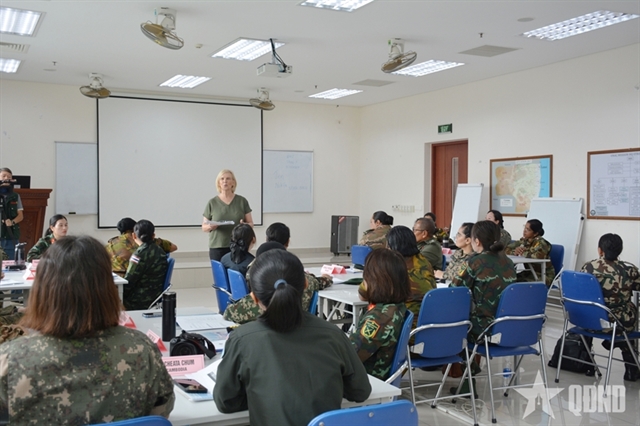A fine tradition of Vietnamese women
The “long haired army” was born as part of the Dong Khoi Movement of Ben Tre province in 1960.It was a response to Decision No 15 of the
The Movement broke out on 17 Jan, 1960 in 3 communes of Mo Cay district of Ben Tre province: Dinh Thuy, Phuoc Hiep, Binh Khanh. The movement then spread over 47 communes throughout 6 districts of Ben Tre. Under the leadership of the Provincial Council, women together with other community membersengaged in armed struggle, using weapons and explosives.They surrounded and attacked enemy bases, calling on them to surrender, seized enemy weapons to equip the people’s forces, ended “strategic hamlets” and destroyed the enemy’s grip on other areas.Their actions led to the liberation of .22 communes, and seizing control of another 22 communes. This uprising was led by a brilliant woman leader - Mme. Nguyen Thi Dinh.
This popular activity continued to achieve victories and the Dong Khoi Movement spread to more and more areas of
This was viewed as the great victory of the Dong Khoi Movement in Ben Tre. It was the typical form of uprising in the rural and plains areas; utilizing two tactics: political action and military action.Itattacked the enemy using three spearhead-attacks: military attacks, political action and agitation among enemy troops.The , appearance of the“long haired army” was particularly effective inface to face attacks against the nerve-centre of the enemy.
From one victory to another, from the Southern delta and
In the Dong Khoi movement of 1960, the people rose up 9 million times and there were nearly 1 million confrontations carried out by women in conjunction with the armed forces. These contributed to the destruction and/or elimination of more than 20 thousand military troops and civil defence forces, freeing 895 communes out of a total of 1,193 southern communes from the grip of the enemy.
From the ebullient momentum of the Dong Khoi movement, in 20 Dec. 1960, the National Liberation Front of South Vietnam was born. And on the 8th of March 1961, the Liberation Women’s Union of South Vietnam was established in order to bring together and unite women of all strata together with Southern people in the anti-US resistance. From the Dong Khoi movement, the long haired army -- the resilient women forces of
Throughout the stages of Anti-US Resistance, women together with all soldiers and people in the South fought back against the U.S, and its puppet army’s “special war”, “partial war” and against the “Vietnamization of the war.”. Women conducted face to face confrontations not only with the puppet troops but also with
The “long haired army” developed increasingly clever applications of the tactic of the three pronged-attack. Women forces were able to utilize the three tactics: political action, military activities and agitation among the enemy troops. one woman was able to fight with all 3 tactics: face-to-face discussion to reason with the enemy; motivating and persuading the soldiers to stop fighting and seizing opportunities to kill the tyrants and eliminate the traitors. When fighting, mothers and women valiantly held their ground, putting into practice the slogan, “Don’t leave even a patch of ground to the enemy”; When preparing for fighting, they militantly targeted the weak spots of the enemy to win them over. And during armed struggles, they were clear, creative and flexible. The forms of struggle were fierce and diverse. Thelong haired army’s fighting forces were increasingly well organized and flexible: encompassing surprise ambushes and frontal attacks and mobilizing forces from different areas.They perfected the development of forces for supply of provisions and logistics as well as for evacuation of casualties.They were also able to replace units as needed with new forces. Throughout this complex military/political battle, all of the long haired army forces were persistent in fighting to win victory.
Using these creative tactics, the “long haired army” was heralded as: “Having the strength to shoot down planes, stop cannons, fight tanks and destroy enemy mopping-up operations.”
In urban areas, the fighting forces of the “long haired army” consisted of women of all strata, including workers, small traders, nuns, Buddhists, teachers, and Intellectuals.The urban women’s forces had harmonious coordination with women from rural areas and from the Western highland areas.They had close coordination with the battlefield to increase the pressure on the enemy.
The Communist Party concluded that Southern women had not only recorded great achievements in agitation work among enemy troops but had demonstrated great abilities in the armed struggle as well.
Hundreds of thousands of women from the mountainous regions to the plains and in urban areas joinedthe guerrillas to save their villages and to defend themselves.They took part in killing the tyrants and destroying the grip of the enemy, fighting back against the American invaders and their puppets with thundering blows.
From the Dong Khoi movement to the General Offensive and the Spring Uprising in 1975, the “long haired army,” a fighting force of women, directly participated in the fight against the enemy, contributing to defeating the puppet troops and puppet government at the grassroots level, and seizing political power and handing it over to people.
The “long haired army” has made a great contribution to the glorious triumph of our national liberation of the South and the unification of the country.
The “long haired army” is deserving of the pride of Vietnamese women and all Vietnamese people.







